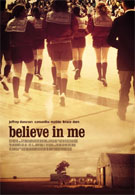Vanilla. Its sweetness is enough to curb a craving, but it’s hardly notable. It’s a flavor that is typically passed up, but it is never completely dismissed. In the film world’s 31 flavors, Believe in Me is vanilla. The film offers a paint-by-numbers story that follows a the new basketball coach in a small Oklahoma town in the 1960s who is assigned to the girl’s team. Despite the storyline’s familiarity, the film side steps the common inspiration sports movie pitfall of being over-wrought with sentiment. And that goes a long way in making Believe in Me as watchable as a lazy Saturday-afternoon matinee, allowing us to get caught up in the melodrama as you watch the dependable story play out just as you’d expect it to.
Clay Driscoll (Jeffrey Donovan), who is based on real-life coach Jim Keith, arrives in the small town of Middleton expecting to be the new head coach of the high school boy’s basketball team. Upon his arrival, he meets Ellis Brawley (Bruce Dern), head of the school board and unofficial owner of the town, who informs him that he’ll be coaching the girl’s team. At this point, you can imagine the obstacles that Driscoll and his team of uncoordinated, giggling girls must overcome both on and off the court. As the girls make the competitive leap out of their losing streak, Mr. Brawley works even harder to secure their failure for no other reason than to spite Driscoll.
While the characters are depthless, they don’t overplay their various conflicts. There aren’t any over-the-top, cringe-worhty inspiration speeches. Even during a banquet scene near the end of the film, the crescendoing sentiment is quickly curbed by Driscoll’s soft-spoken and guarded demeanor. Although the cast is largely responsible for the film’s tone, director Robert Collector easily avoids many melodramatic trappings through dialogue about an event rather than showing the event. When a girl on the team is having a baby and calls Discoll for help for example, Collector shows only before and after the birth. By skipping the birth scene, Collector avoids the excessive emotion and keeps the film focused on the characters.
Unfortunately, this technique leaves the film often feeling disjointed and rushed. Like adding sprinkles to vanilla ice cream, Collector uses a series of close- to mid-range shots to speed up the action and spice up the basketball game sequences. In doing so, he creates a bit of confusion, as we never really know how a game is playing out. At the end of the girl’s first season, they apparently won six games, but all we saw were losses. In the sport movie genre, the game scenes are a time for the film to shine, but Collector’s reluctance to use a wide shot to show the action severally limits the scenes’ impact. There is only one time, in the film’s finale, that Collector uses a wide court shot to show the action, and its effect is astounding. That single shot is comes across as a believable docu-drama, and it’s the only play in a game sequence that is seen with clarity.
Yet, Collector’s respect for the story is clear throughout the film to the point that he wouldn’t sensationalize the story anymore than it needed to be to play on screen. The most interesting display of respect takes place during the credits, when the real-life women are gathered to talk about their experience with Jim Keith, the coach who inspired the film. The participation of these women begs the question, “why didn’t Collector go the docu-drama route and cut interviews in with the real-life women with the recreation of the events at the time?” Considering that the names and place have been changed, it might have been a logistics decision to pursue the film as a drama and avoid a legal debacle. While addition of true-story testimonies could have made Believe in Me the torch barer for women’s basketball, it does an admiral job of creating a melodrama that doesn’t sicken the audience with sentiment.
Your Daily Blend of Entertainment News

